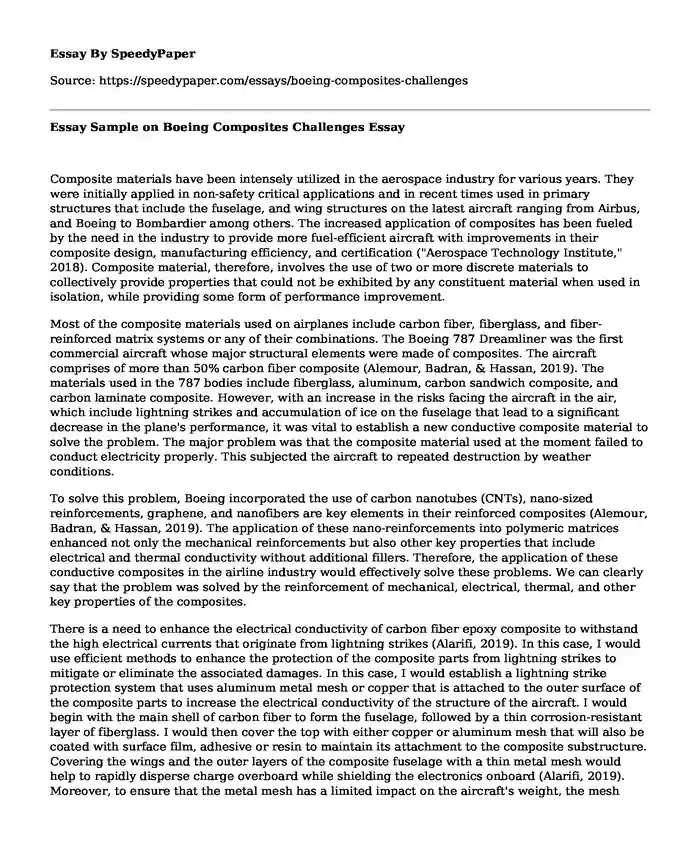
| Type of paper: | Case study |
| Categories: | Engineering Aviation Airline industry |
| Pages: | 3 |
| Wordcount: | 646 words |
Composite materials have been intensely utilized in the aerospace industry for various years. They were initially applied in non-safety critical applications and in recent times used in primary structures that include the fuselage, and wing structures on the latest aircraft ranging from Airbus, and Boeing to Bombardier among others. The increased application of composites has been fueled by the need in the industry to provide more fuel-efficient aircraft with improvements in their composite design, manufacturing efficiency, and certification ("Aerospace Technology Institute," 2018). Composite material, therefore, involves the use of two or more discrete materials to collectively provide properties that could not be exhibited by any constituent material when used in isolation, while providing some form of performance improvement.
Most of the composite materials used on airplanes include carbon fiber, fiberglass, and fiber-reinforced matrix systems or any of their combinations. The Boeing 787 Dreamliner was the first commercial aircraft whose major structural elements were made of composites. The aircraft comprises of more than 50% carbon fiber composite (Alemour, Badran, & Hassan, 2019). The materials used in the 787 bodies include fiberglass, aluminum, carbon sandwich composite, and carbon laminate composite. However, with an increase in the risks facing the aircraft in the air, which include lightning strikes and accumulation of ice on the fuselage that lead to a significant decrease in the plane's performance, it was vital to establish a new conductive composite material to solve the problem. The major problem was that the composite material used at the moment failed to conduct electricity properly. This subjected the aircraft to repeated destruction by weather conditions.
To solve this problem, Boeing incorporated the use of carbon nanotubes (CNTs), nano-sized reinforcements, graphene, and nanofibers are key elements in their reinforced composites (Alemour, Badran, & Hassan, 2019). The application of these nano-reinforcements into polymeric matrices enhanced not only the mechanical reinforcements but also other key properties that include electrical and thermal conductivity without additional fillers. Therefore, the application of these conductive composites in the airline industry would effectively solve these problems. We can clearly say that the problem was solved by the reinforcement of mechanical, electrical, thermal, and other key properties of the composites.
There is a need to enhance the electrical conductivity of carbon fiber epoxy composite to withstand the high electrical currents that originate from lightning strikes (Alarifi, 2019). In this case, I would use efficient methods to enhance the protection of the composite parts from lightning strikes to mitigate or eliminate the associated damages. In this case, I would establish a lightning strike protection system that uses aluminum metal mesh or copper that is attached to the outer surface of the composite parts to increase the electrical conductivity of the structure of the aircraft. I would begin with the main shell of carbon fiber to form the fuselage, followed by a thin corrosion-resistant layer of fiberglass. I would then cover the top with either copper or aluminum mesh that will also be coated with surface film, adhesive or resin to maintain its attachment to the composite substructure. Covering the wings and the outer layers of the composite fuselage with a thin metal mesh would help to rapidly disperse charge overboard while shielding the electronics onboard (Alarifi, 2019). Moreover, to ensure that the metal mesh has a limited impact on the aircraft's weight, the mesh geometry open area can be increased and the thickness of the mesh can be reduced.
References
"Aerospace Technology Institute" (2018). Composite Material Applications in Aerospace. Compositesuk.co.uk. Retrieved from https://compositesuk.co.uk/system/files/documents/INSIGHT09-COMPOSITES.pdf
Alarifi, I. (2019). Investigation of the conductivity of carbon fiber composites focusing on measurement techniques under dynamic and static loads. Journal Of Materials Research And Technology, 8(5), 4863-4893. doi:10.1016/j.jmrt.2019.08.019
Alemour, B., Badran, O., & Hassan, M. (2019). A Review of Using Conductive Composite Materials in Solving Lightning Strike and Ice Accumulation Problems in Aviation. Journal Of Aerospace Technology And Management. doi:10.5028/jatm.v11.1022
Cite this page
Essay Sample on Boeing Composites Challenges. (2023, Apr 05). Retrieved from https://speedypaper.com/essays/boeing-composites-challenges
Request Removal
If you are the original author of this essay and no longer wish to have it published on the SpeedyPaper website, please click below to request its removal:
- Peace, Propaganda and the Promised Land - Free Essay with Documentaries Analysis
- Creative Writing Essay Sample - The Missed Chapter of The Wars Book
- Sports Fundraising Plan, Free Paper for Everyone
- Free Essay: Experiences with Race and Assimilation
- Horner's Mind Your Faith: Reading Report, Free Example
- Essay Sample on The Concept of Inflation
- Free Essay - Leadership Change Analysis
Popular categories




